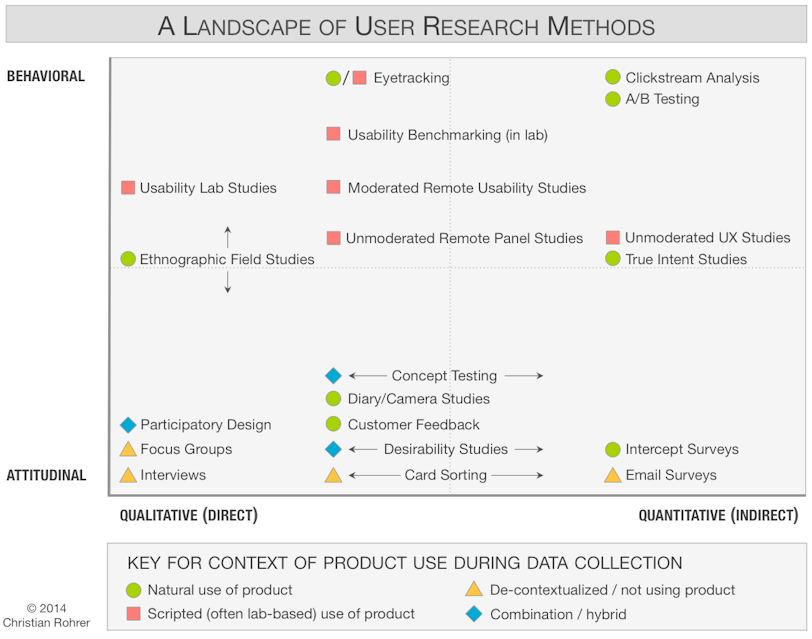UX testing (also known as user testing) is a valuable building block of UX design. It’s an essential set of tools that allow us to create relevant and useful products.
UX research methods achieve this by studying users and learning about their needs and motivations. This “learning” comes in a variety of shapes and forms, many of which we’ll touch on today.
In this article, we’ll also look into what kind of research you should conduct based on your budget, time limitations, and development phase.
Let’s dive right in, shall we?
Why test your design decisions?
One of the central reasons why UX testing is necessary in the first place is bias, both personal and cognitive. We often automatically assume that what we consider to be good or relevant is true for other people around us.
As user experience specialists, we strive to move past our personal convictions and shift our focus outwards.
We are not our users — this is why there is such a broad inventory of research methods. It helps us learn more about a group of people and calibrate our assumptions about their needs and views when designing a product.
What kinds of UX testing are there?
UX testing offers us a variety of tools. However, these tools don’t fall into clear-cut, mutually exclusive categories. It’s best to look at them as a 2D landscape. This method landscape has two axes: “behavioral and attitudinal methods” and “quantitative and qualitative methods.”

There is another category of UX testing called “controlled and contextual” methods, which focuses on the environment in which the tests are conducted.
Let’s take a closer look at these categories.
Behavioral vs. attitudinal methods
We don’t always act as we speak — and that’s totally fine. But, this is the reason why the distinction between behavioral and attitudinal research methods exists.
Behavioral methods focus on what users do and how they behave when they’re solving specific issues or tasks. Attitudinal methods, on the other hand, focus on the opinions that participants express.
Attitudinal methods include focus groups, surveys, and one-on-one interviews, etc.
Behavioral methods include field studies, card sorting, tree testing, heat maps, benchmarking, etc.
Quantitative vs. qualitative methods
The most apparent distinction between qualitative and quantitative methods is the type of data they yield.
Quantitative methods gather the information that is expressed in numbers or values. Whereas, the qualitative ones focus on the quality of human experience, which is way too ambiguous to be expressed in zeroes and ones.
Qualitative methods are best suited to answer questions like “How should we fix this problem?”. In contrast, quantitative methods are far better at answering questions that start with “How much…” and “How many…”.
Quantitative methods include analytics, questionnaires, A/B testing, heat maps, etc.
Qualitative methods include user and stakeholder interviews, usability testing, shadowing, guerrilla testing, etc.
Controlled vs. contextual methods
The main distinction between the two of these is the environment in which the research is conducted.
Controlled tests are set up and held in a designated place, typically in a lab or office. On the other hand, contextual methods are conducted in the users’ “natural habitat” — their home, or an environment they’re familiar with.
A pitfall of controlled methods is the potential discomfort that respondents experience during the tests.
There is a host of factors that can contribute to it — from dehydration to spending an hour in traffic on their way there. Therefore, it’s essential to be mindful of the participant’s well-being during controlled tests.
When and why use specific research methods?
There is a plethora of factors that go into defining the most suitable UX research methods. Essentially, we need to look into the costs, the time constraints, and where you are in the development stage. They are far from being the only factors but are certainly the most important ones.
Costs
Research costs vary, so do teams’ budgets. But lack of budget is not an excuse to ditch testing altogether. Around 70% of projects fail due to a lack of user acceptance. So avoiding to invest money in research can have lots of unpleasant repercussions.
If your company can afford to allocate a handsome amount to conduct large-scale studies — that’s amazing. If not, there are plenty of inexpensive UX testing methods that are very impactful and efficient. Generally speaking, Qualitative analysis is cheaper.
If your research budget isn’t impressive, consider investing some time into practices like desk research, usability testing, guerrilla testing, online surveys, and focus groups.
Time
It’s generally considered that quantitative methods tend to take more time than the qualitative ones. The latter often involve longer-term observations and analysis. Therefore, when working around time constraints, it’s best to go with qualitative methods.
Development stage
Not all UX testing methods can be used at all times — context really matters. Card sorting or tree testing aren’t really that effective when you have a working design on your hands.
When your product is in the “discovery” phase, your UX tests should aim for inspiration, exploration, and forming empathy for users.
During this period, you should look into methods like field studies, card sorting, diary studies, desk research, and so forth. All of them will allow you to collect information about the context in which your product will exist and the users that it will serve.
When in the “design and prototyping” phase, our goal is to ensure that our product’s design is easy to use and free of massive friction sources. It’s best to opt for usability testing, prototype and interaction validation, and heat maps during this period.
When you have a first working iteration of your product, it’s important to measure its performance against specific benchmarks. Therefore, it’s best to choose tests like usability benchmarking, A/B testing, surveys, and analytics.
Conclusion
UX testing is an invaluable part of a product’s lifecycle during all development phases. Lack of budget or time does not, by any means, suggest that we should skip UX research altogether. A lack of understanding of our users and the market can hinder the development of the product as well as have a negative impact on its viability.





